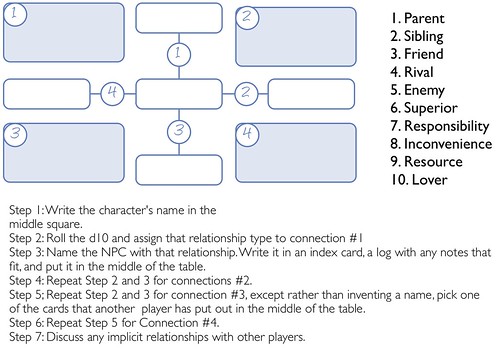This is not technically part of Index Card Tactics, though it’s related, in that another part of ICT is that it uses situation generators like Two Guys With Swords. This is another such tool (and don’t worry, I’ll be getting onto classes and equipment and so on).
This trick works best for a group of 4 or 5 who either have some sense of their character or who are willing to make things up enthusiastically.
- Hand each player an index card. Have them write the name of one NPC who is very important to their character, with perhaps a single sentence description of who they are and why they matter. Broad strokes.
- Pass the card to the player on your left (not the GM).
- On the card they have received, the player now writes down something bad that might happen to the person named. This should not have a lot of details outside of the character, so “Stripped of their title” is good but “Stripped of their title by the Cardinal” is not.
- Pass the card to the player on your left (not the GM).
- On the card received, the player now writes down a good outcome, flavored by the bad one. It should not merely be “The bad thing doesn’t happen” but rather an outcome that might be hoped for over and above mere nullification. To continue the example of stripped of title, “Be honored by the king” would work well.
- Pass the card to the player on your left (not the GM).
- On the card received, the player now writes down who wants the bad outcome to happen.
- Pass cards back to the first player.
- Player looks at the situation as presented and – privately – writes their rating on the card, representing their interest in seeing this in play. Ratings are from 0 (I actively hate this, and never want it to see the light of day) to 5 (This is AWESOME, I totally want this) .
- Cards are handed over to the GM.
- GM looks through the cards and, based on interest level, puts them in motion.
- Step one assumes a friendly NPC. It’s possible to allow it to be a hated NPC, in which case that should be noted on the card, and the logic of step 7 inverts to “Who wants the good outcome for this character?”
- It is possible for Step 1 to be something other than a character, such as a town or organization. For certain games (conspiracy oriented one, frex) that might be apt, but go easy on it.
- Step 7 is fre-form as presented, but if you’re using a game with an existing cast of characters “in play” (like a Dresden Files City, a tech Noir playset, or even something like Apocalypse World’s fronts) then the character selected should be drawn from that list, or tied to that element.
- In step 11, Player rating is important to determining plot relevance but it’s also a useful yardstick for difficulty. That is, a low-interest situation should also be one that is reasonably easy to resolve.
- In step 11, one challenge to the GM is how to tie things together when player interest is high. This is, to my mind, one of the fun things about bing a GM.
- In Step 11, If interest is across the board low, then that may be a reason to check your table. Is it that your players have radically different tastes and they’re spilling on each other? Are they looking for more of a monster smash this evening? Do the NPCs really not grab them? Only you can really know your table, but take it as a cue to think about it.
